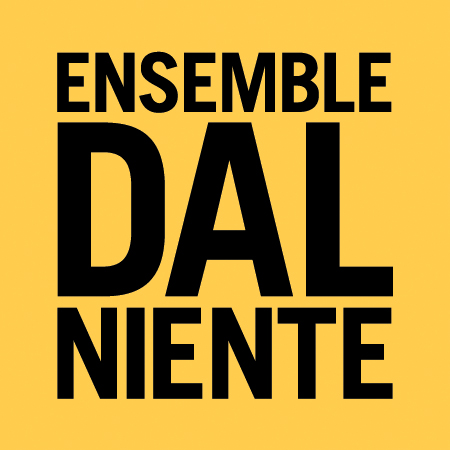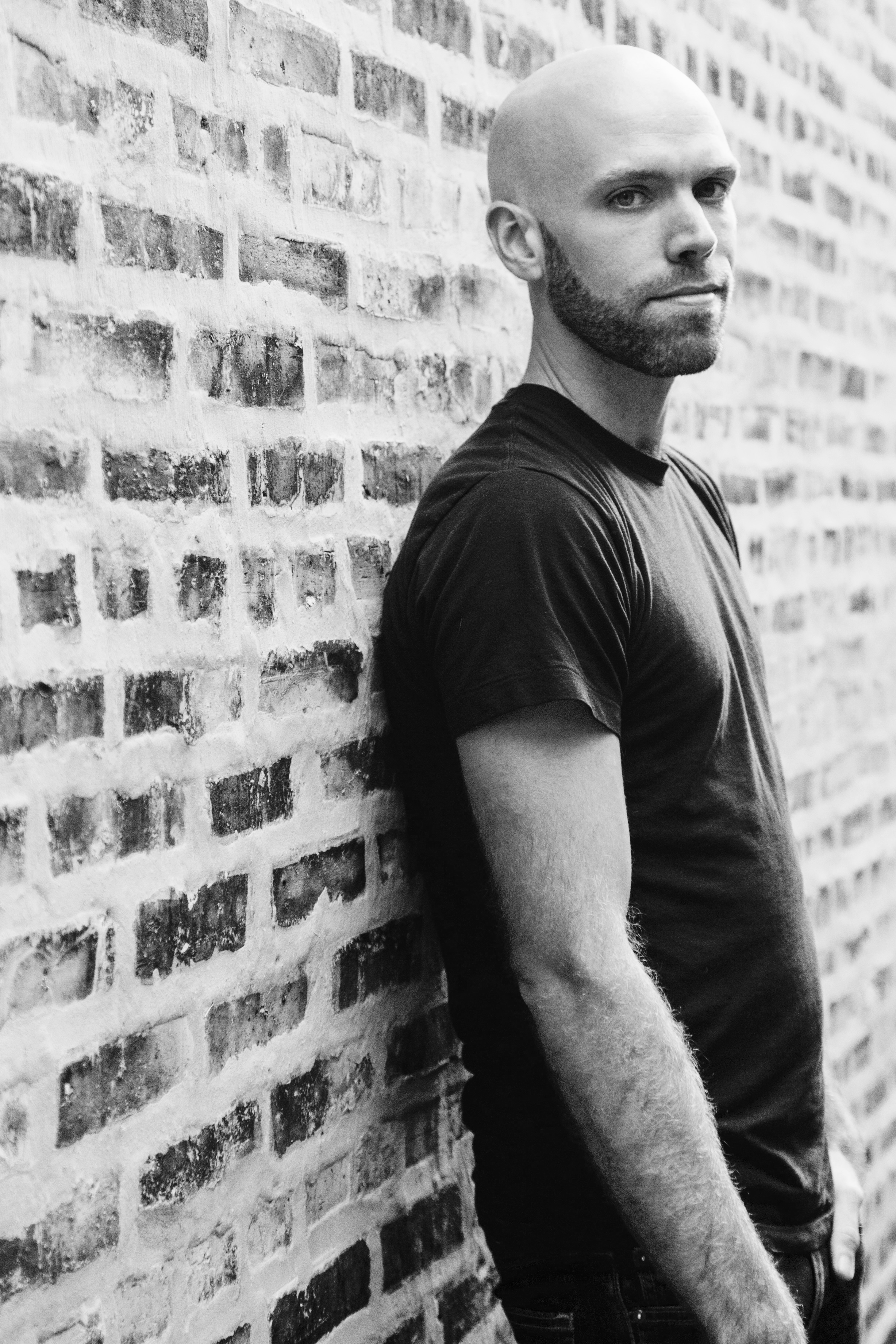Emma Hospelhorn chats with Jeff Parker about the piece he wrote for Dal Niente, Water on Glass.
Interview: L.J. White on We Don't Eat Dead Things
Dal Niente violist Ammie Brod sat down with LJ White to talk about his piece We Don’t Eat Dead Things, which was commissioned for Dal Niente in 2017 and will be released as part of object/animal , out March 25 on Sideband Records.
I Won't Be Outrun by a Cavalry of Snails: Interview with Osnat Netzer
Interview: Katinka Kleijn on Forward Echo
Interview: Pierce Gradone on writing for Andy Nogal
Luis Fernando Amaya on Bestiario: Tres - Animacy, Agency, and the Secret Life of Music
Interview: Ben Melsky on the many voices of the harp
Ammie Brod sat down with Ben Melsky to talk about his new record, Ben Melsky / Ensemble Dal Niente, and the process of creating new music for the harp.
Chris Fisher-Lochead: Stutter-Step Revisited
One of the cornerstones of Party 2018 is “stutter-step the concept” by longtime ensemble friend (and fan) Chris Fisher-Lochhead. Originally premiered by Dal Niente at the Ear Taxi Festival, we’ll be playing an updated and expanded version on June 2nd. Dal Niente violist Ammie Brod chatted with CFL about his revision process, creative sources, and baroque object rotation.
Ammie: So we played this piece before, in 2016, but I know you’ve made some substantial revisions since then. Wanna talk about that?
CFL: I wrote stutter-step during a really chaotic period in my life - I was finishing grad school, working on my dissertation, and moving to a totally different part of the country - so my original creative process felt a little rushed and hectic. Basically, I liked the piece but I also knew I wanted to do more with it. In addition, I like it when creative processes are allowed to have multiple stages, and my revisions had more of an additive quality than anything like a total reworking. I wanted to layer more material on top of the structural skeleton I’d already built, to embellish and flesh it out, not to totally reconceive the piece.
Ammie: When we initially played this piece, I know we were all really struck by a sentence in the performance notes where you describe the piece as “a baroquely detailed physical object which is slowly rotating, exposing its many aspects,” and then you go on to talk about how the piece is a series of sonic “slices” of musical material. Those two ideas really form an interesting picture of the piece before it even gets going, and I’d like to talk about how you got there.
CFL: My basic approach to this particular piece came from a desire to consciously channel my love of hip-hop into a notated work. I intentionally drew on the tradition of building beats out of samples, discrete units of material, which are the “slices” I’m talking about. I love how hip-hop uses unexpected juxtapositions to create something new that can’t really be achieved through other means, and I wanted to use that idea to build a sonic surface like a mosaic of heterogeneous musical atoms. I mean, I don’t think anybody could reverse-engineer their way from my piece to hip-hop without knowing the connection, but there it is. The initial work was very pointilistic and intentionally didn’t smudge boundaries or create larger washes; it wasn’t really trying to go anywhere, but was instead an exploration of ways to look at the components that it’s built from. In this updated version, I did allow some amount of more intuitive creativity. Basically, I wanted to take the sampling technique and allow the ways in which those samples are combined to give rise to a fuller musical language. In my mind, I was thinking of this as an analog of the linguistic process of creolization, in which severed and decontextualized pieces of different languages integrate throughout generations to form a new systematic whole.
The way I intuitively crafted these embellishments on the slice structure feels reminiscent of improvisatory group dynamics. As an improviser myself, I've thought a great deal about how to create some sense of coherence and individuation within an ensemble where everyone is improvising. Of course, in this case, the level of detail and complexity that is prescribed in the score is totally unlike the ethos of freedom in improvised music; but, for me, both approaches serve a similar purpose. Reflecting on this kinship between improvisation and notational complexity reminds me of a personal epiphany I had in my early twenties. At the time I was really anti-complexity, but one morning as my music library was playing on shuffle, I ended up hearing John Coltrane's Sun Ship and Brian Ferneyhough's Second Quartet back-to-back. Right then, it clicked for me that both musicians were trying to do similar things in entirely different ways. Coltrane was using these unruly rhythmic gestures and pairing them with an intimate and extensive knowledge of how his instrument worked to articulate a revelatory catharsis of musical energy; Ferneyhough was applying a deeply considered critical awareness of how musical notation works and what instrumentalists are capable of within that framework and doing the same thing by stretching notation and technique to the breaking point. Realizing that these two different approaches could provoke similar outcomes broke the spell of some pretty naive aesthetic prejudices that I was holding on to at that time.
Ammie: Yeah, I definitely wasn’t like, ah yes, hip-hop, when I got my part, but that makes sense. What else went into this piece that the listeners (and musicians) might not know?
CFL: When I was looking back on this, I realized that it was written in the middle of the 2016 presidential campaign. I remember thinking a lot about the overt use of images and words to coerce, cajole, or persuade people, and I was so disgusted by that constant manipulation that I think I subconsciously tried to avoid narrative musical devices. I came to think of the music as something formally concretized, not as a temporal succession of sounds organized tendentiously to elicit an emotional reaction. In other words, I imagine that the experience of listening to the piece would be more like viewing a sculpture than hearing a story, thus the object rotating metaphor.
“stutter-step the concept” comes to Constellation Chicago on June 2nd as part of Party 2018. You can find more information about the other pieces on the program (shadow puppets! escalators!) and ticket information here.
Teaser: Chris Fisher-Lochhead's "stutter-step the concept"
One of the centerpieces of Party 2018 is Chris Fisher-Lochhead's "stutter-step the concept". We'll have more from Chris in a few days about his ongoing work with this piece, but for now here's a look back on our 2016 premiere (and a few words from Chris about his process).
"In hip-hop beat-making, I am drawn to the way that samples, found sonic objects pried from their original contexts, are able to reassemble a musical intelligibility in their new settings, much like the linguistic process of creolization. In stutter-step the concept, I tried to mimic and leverage this formal process."
Party 2018 hits Chicago June 2nd at Constellation Chicago. Are you ready?
Sky Macklay: Escalator
Sky Macklay’s new piece for Dal Niente, to be premiered at Party 2018 on June 2nd, is a double concerto for oboe and horn that the composer has described as “wacky”. Violist Ammie Brod skyped (well, google hangout video chatted, because she’d forgotten her skype password) with Sky about mega-instruments, people movers, and her dual roles as a composer and performer of new music.
Ammie: So your new piece for Dal Niente is called Escalator! That’s such a fun name, and I’d love to hear more about why you chose it.
Sky: Well, I think this piece has a lot in common with the multitude of experiences you might have while riding on an escalator or moving walkway: accelerating, getting blocked by people, stopping and starting, and the whiplash of getting off. The musical material plays with drastic accelerations and decelerations of energy and dramatic directional stuff, sharp ups and downs.
*Cue dramatic story about dog poop, a moving walkway, and the horrifying confluence thereof*
Ammie: Wow! Well, back to the music, now that I have a new and very vivid little mental movie to reflect on... Can you tell me more about that musical motion and overall structure?
Sky: The piece basically has three sections. In the first, the horn and oboe play together to form a sort of mega-instrument (interviewer’s note: YESSSS), starting simply with a sort of sad little three-note descending gesture. That gesture gets expanded through a transparent and additive process, getting longer and more heterophonic as other instruments join and start decorating the same expanding phrase. It’s like the steps on the escalator: you start on one, but as you go up or down there’s a longer and more advanced line of them marching out behind you.
The second section starts fast and aggressive, lots of overblown low notes and playing up and down in a single overtone series, and then gets slower and more drone-y as it continues. As it moves into the third section there’s more back and forth between the oboe and horn inside of increasingly perceivable compound meters, jaunty bouncy gestures. The horn and oboe dialogue back and forth with the horn playing pitches related to the oboe multiphonics, and the strings are in this kind of weird A-minor circle-of-fifths thing, coming together briefly for chords that immediately dissolve upward into noisy clustery gestures. The whole thing plays with tonal information from the oboe multiphonics, and starts in the world of metered classical music but then goes to weird places from there.
Ammie: Why horn and oboe? I mean, I love it, but that’s not a combination that I get to hear a lot of.
Sky: When I started talking with Dal Niente about this piece, you expressed interest in writing for some of the less-programmed instruments in the ensemble, and since I play the oboe and I knew Matt and Andy would be down for anything it seemed like a logical choice. I also included harp and guitar for the same reasons, and as it turns out they’ve ended up acting as the kind of disturbing force within the string section.
Ammie: Matt and Andy are totally down for anything! I do know, though, that you’ll actually be playing the oboe solo for the premiere. Can we talk a little bit about what it’s like to perform your own music with other people?
Sky: Sure! I actually perform my own music pretty regularly with a group that I play in called Ghost Ensemble. I wrote a piece called 60 Degree Mirrors that we play regularly, and I’ve enjoyed that because I know so intimately what I want from the parts, and my part in particular, and I can make changes and add small details on the fly as we play it more times. In some ways it’s a lot easier than playing music by other composers, because I know just how flexible I can and want to be with the music.
Ammie: A related question: has that experience changed your relationship to other performers who are playing your music?
Sky: I really like asking for and hearing performers’ opinions. Sometimes performers will have a better way to get to the idea that I had when I was writing the parts, and discussion is a good way to ensure that we all know what that idea is. I’m really open to that discussion, and I definitely want it to feel like I’m welcoming others to the conversation.
Sky Macklay’s new piece, “Escalator”, will premiere on June 2nd at Constellation Chicago as part of Ensemble Dal Niente's Party 2018. This commission is generously supported by the Fromm Foundation.











